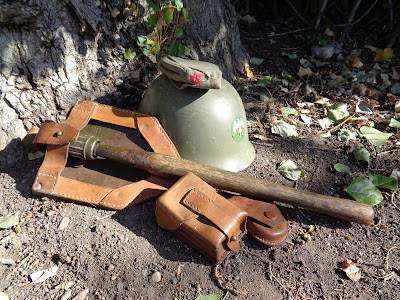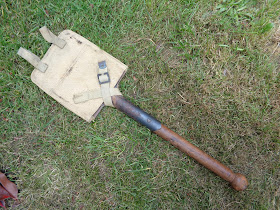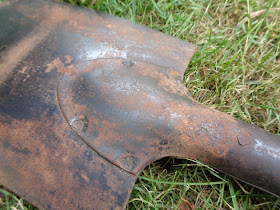I have been on a quest lately, to match all of my shovels with a corresponding cover. I did an inventory, and realized I had a US Model 1943 shovel that needed a cover. I also noticed that I did not have a Yugoslavian, post-war cover in the collection. Well, I found a solution for both open spots.
I located a great deal on a post-war, Yugoslavian, leather shovel cover, and picked it up.
What makes this a perfect solution, is that Yugoslavia used the old, M-1943, US folding shovels, from 1951, until their break up in 1992. I just happened to have a 1945 dated US shovel without a cover, and now I had a Yugoslavian cover without a shovel. To solve the dilemma, I paired the US shovel with the Yugo cover, and gave the US shovel a new "identity", as a post-war Yugoslavian shovel. Problem solved!
After the end of WW2 in Germany, the US military ended up with a number of warehouses filled with old German Wehrmacht, and US military surplus gear that needed a good home. In 1950, the Mutual Defense Assistance Program (MDAP) was signed into existence. This allowed the US to supply various countries with surplus gear and equipment from these left over surplus piles. All of the gear in the warehouses was deemed to be of negligible value to the new NATO forces. In 1951, Yugoslavia made a request for equipment and were approved under the MDAP. Nearly all of the field gear they received was a used mix of German and US items. Yugoslavia was given a very large quantity of US M-1943 folding shovels, as well as German helmets and various other leather gear items. Along with the field gear, the US transferred Sherman Tanks and other light armored vehicles, some artillery, and various small arms to the new Yugoslavian military. It is interesting to note, that in the early post-war years, most of the Yugoslavian army were wearing WW2 vintage German helmets, carrying K98 rifles, and carrying US M-1943 shovels, all while maneuvering with US Sherman tanks! It is interesting to note that Yugoslavia was the first, and only, Com-Bloc country to receive equipment through this program.
Yugoslavia used this mash up of German and US surplus equipment until 1959, when they standardized, and modernized, their field equipment with their own designs.
In 1959, Yugoslavia kept the US M-1943 shovels, but designed their own leather carrier, based on the old German style folding shovel carriers. They also came out with their own style helmet, ammo pouches, and other items as well. Yugoslavia continued to use the US shovels in the M-59 leather covers until 1992, when Yugoslavia broke up. After that date the US style, tri-fold shovels came into regular use in Serbia, Bosnia, etc. (the post-Yugoslavia countries).
NOTE: According to one of my blog readers, Miloš Reža, Yugoslavia received the M-1943 US shovels without covers. The Yugoslavian army first constructed their own version of the US canvas covers, and then later, issued the leather covers. When the Serbian (post-Yugoslavian era) Army started issuing tri-fold shovels, the old US shovels and covers were placed in reserve storage.
From what I can tell, in 1959, there was a complete redesigning of the basic soldier's field gear. Natural leather Y-straps, ammo pouches, rifle slings, and shovel covers were added (you can see one of the SKS ammo pouches and an oil bottle carrier in the opening group photo). These leather items had embossed edging lines and "chrome" plated steel rivets. I would assume that Yugoslavia used the older, canvas, M-43, US shovel covers, until the M-59 leather covers were issued out.
My shovel cover is in very good condition for it's age. When I received it, it was missing one of the upper corner rivets. I made a "shop replacement" rivet out of copper and aged it to blend in. The new rivet is now "part of its history".
The original rivets are a tube-type rivet that is very long. The mushroomed over, tube side, is machine pressed into a wide, flat backing. I have been unable to locate tube rivets that are long enough, and I lack the means to mushroom the back into the wide, flat backing. So, I did the next best thing, and that is to traditionally rivet the corner with a long copper rivet, peened with a brass washer. I finished the repair with a bit of patina on the new rivet to blend it in.
The cover is a very snug fit, but it was obviously made for the US M-43 shovels.
This project was an interesting solution to the "US-Yugoslavia entrenching tool", hole in the collection. The US M-43 shovels are easy to come by, and the Yugo covers are seldom found with a shovel, so the answer was easy, "reconstruct" a Yugoslavian "issue set", by combining my orphan US shovel with an original Yugo leather cover. All in all, it is a great addition to the collection!
Let's take a closer look.













































